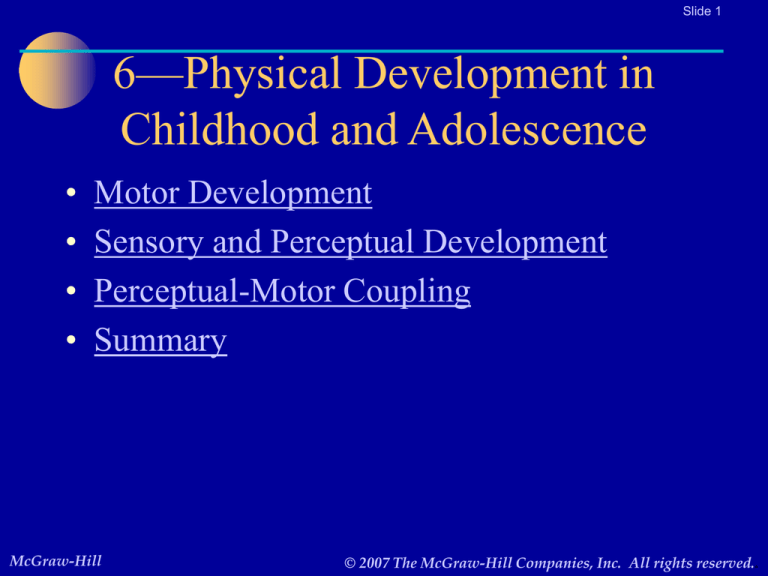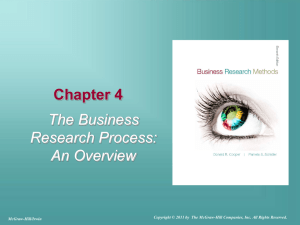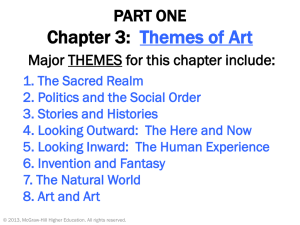
Slide 1
6—Physical Development in
Childhood and Adolescence
•
•
•
•
Motor Development
Sensory and Perceptual Development
Perceptual-Motor Coupling
Summary
McGraw-Hill
© 2007 The McGraw-Hill Companies, Inc. All rights reserved..
Slide 2
Motor Development
• The Dynamic Systems View
– The traditional maturational view of Arnold Gesell
(1934) proposed that universal milestones, such as
crawling, reaching, and walking, develop through the
unfolding of a genetic plan, or maturation.
– The dynamic systems theory asserts that motor
development is not a passive process.
• Infants assemble motor skills for perceiving and
acting; to develop motor skills, infants must
perceive something in the environment that
motivates them to act and use their perceptions to
fine-tune their movements.
McGraw-Hill
© 2007 The McGraw-Hill Companies, Inc. All rights reserved..
Slide 3
Motor Development
• Reflexes
– Built-in reactions to stimuli that govern the newborn’s
movements, which are automatic and beyond the
newborn’s control.
– They allow infants to respond adaptively to their
environment before they have had the opportunity to
learn.
McGraw-Hill
© 2007 The McGraw-Hill Companies, Inc. All rights reserved..
Slide 4
Motor Development
• Reflexes (continued)
– Rooting reflex:
• When the infant’s cheek is stroked or the side of the
mouth is touched, the infant turns its head toward
the side that was touched in an apparent effort to
find something to suck.
– Sucking reflex:
• A newborn’s built-in reaction of automatically
sucking an object placed in its mouth. The sucking
reflex enables the infant to get nourishment before it
has associated a nipple with food.
McGraw-Hill
© 2007 The McGraw-Hill Companies, Inc. All rights reserved..
Slide 5
Motor Development
• Reflexes (continued)
– Moro reflex
• Occurs in response to a sudden, intense noise or
movement. When startled, the newborn arches its
back, throws its head back, and flings out its arms
and legs. The newborn rapidly closes its arms and
legs to the center of the body.
– Grasping reflex
• When something touches the infant’s palms, the
infant responds by grasping tightly.
McGraw-Hill
© 2007 The McGraw-Hill Companies, Inc. All rights reserved..
Slide 6
Motor Development
• Reflexes (continued)
– Some reflexes, such as coughing, blinking, and
yawning, persist and continue to be important
throughout life.
– Other reflexes disappear several months following birth
as the brain matures and voluntary control over many
behaviors develops.
McGraw-Hill
© 2007 The McGraw-Hill Companies, Inc. All rights reserved..
Slide 7
Motor Development
Infant Reflexes
• Refer to Figure 6.1
McGraw-Hill
© 2007 The McGraw-Hill Companies, Inc. All rights reserved..
Slide 8
Motor Development
• Gross Motor Skills
– Motor skills that involve large muscle activities, such as
moving one’s arms and walking.
McGraw-Hill
© 2007 The McGraw-Hill Companies, Inc. All rights reserved..
Slide 9
Motor Development
• Gross Motor Skills (continued)
– Posture:
• A dynamic process linked with sensory information
from proprioceptive cues in the skin, joints, and
muscles that tell us where we are in space; from
vestibular organs in the inner ear that regulate
balance and equilibrium; and from vision and
hearing.
McGraw-Hill
© 2007 The McGraw-Hill Companies, Inc. All rights reserved..
Slide 10
Motor Development
• Gross Motor Skills (continued)
– Learning to Walk:
• To walk upright, the baby must be able to balance
on one leg as the other is swung forward and to shift
weight from one leg to the other.
McGraw-Hill
© 2007 The McGraw-Hill Companies, Inc. All rights reserved..
Slide 11
Motor Development
The Role of Experience in Crawling and
Walking: Infants’ Judgment of Whether to
Go Down a Slope
• Refer to Figure 6.2
McGraw-Hill
© 2007 The McGraw-Hill Companies, Inc. All rights reserved..
Slide 12
Motor Development
Milestones in Gross Motor Development
• Refer to Figure 6.3
McGraw-Hill
© 2007 The McGraw-Hill Companies, Inc. All rights reserved..
Slide 13
Motor Development
• Gross Motor Skills (continued)
– Development in the Second Year
• Increased motoric skills and mobility.
• First they can pull toys attached to strings, use hands
and legs to climb; then walk quickly or run stiffly,
balance in a squat position, walk backward, stand
and kick or throw a ball, and jump in place.
• Experts recommend against structured exercise
classes for babies.
• There are cultural variations for guiding infants’
motor development.
McGraw-Hill
© 2007 The McGraw-Hill Companies, Inc. All rights reserved..
Slide 14
Motor Development
• Gross Motor Skills (continued)
– Childhood
• Age 3: Use simple movements, such as hopping,
jumping, and running back and forth.
• Age 4: Are more adventuresome, use jungle gyms,
climb stairs with one foot on a step for some time
and just beginning to come down the same way.
• Age 5: Are more adventuresome with climbing, run
hard and enjoy racing.
• Middle to late childhood: Movements are smoother
and more coordinated due to greater control over
their bodies.
McGraw-Hill
© 2007 The McGraw-Hill Companies, Inc. All rights reserved..
Slide 15
Motor Development
•Fine Motor Skills
– Motor skills that involve more finely tuned movement,
such as finger dexterity:
• Infants have little control over fine motor skills at
birth; development of reaching and grasping
becomes more refined during the first 2 years of life.
• Perceptual-motor coupling and experience are
important for developing reaching and grasping.
McGraw-Hill
© 2007 The McGraw-Hill Companies, Inc. All rights reserved..
Slide 16
Motor Development
Infants’ Use of “Sticky Mittens” to Explore
Objects
• Refer to Figure 6.4
McGraw-Hill
© 2007 The McGraw-Hill Companies, Inc. All rights reserved..
Slide 17
Motor Development
• Fine Motor Control (continued)
– Childhood
• Age 3: Clumsily pick up tiny objects between thumb
and forefinger, build high block towers.
• Age 4: Have more precise coordination.
• Age 5: Hands, arms, and fingers move together
under better command of the eye.
• Middle and late childhood: Increased myelination
enhances dexterity and control; by age 7 they prefer
pencils rather than crayons for printing.
McGraw-Hill
© 2007 The McGraw-Hill Companies, Inc. All rights reserved..
Slide 18
Motor Development
• Handedness
– A preference for using one hand rather than the other;
right-handedness is dominant in all cultures.
– Origin and development of handedness: Genetic
inheritance is likely strong.
McGraw-Hill
© 2007 The McGraw-Hill Companies, Inc. All rights reserved..
Slide 19
Motor Development
• Handedness (continued)
– Handedness and Other Characteristics
• Speech processing is more likely in the left
hemisphere of right-handed individuals, while lefthanded individuals show more variation.
• Left-handers are more likely to have reading
problems, but tend to have unusually good spatial
skills.
• Left-handers are more common among
mathematicians, musicians, architects, and artists.
McGraw-Hill
© 2007 The McGraw-Hill Companies, Inc. All rights reserved..
Slide 20
Review and Reflect: Learning
Goal 1
• Describe how motor skills develop
– Review
•
•
•
•
•
McGraw-Hill
What is the dynamic systems view of development?
What are some reflexes of infants?
How do gross motor skills develop?
How do fine motor skills develop?
How does handedness develop?
© 2007 The McGraw-Hill Companies, Inc. All rights reserved..
Slide 21
Review and Reflect: Learning
Goal 1
– Reflect
• How would you evaluate the benefits and drawbacks
of allowing an 8-year-old to play Little League
baseball?
McGraw-Hill
© 2007 The McGraw-Hill Companies, Inc. All rights reserved..
Slide 22
Sensory and Perceptual
Development
• What Are Sensation and Perception?
– Sensation
• The product of the interaction between information
and the sensory receptors—the eyes, ears, tongue,
nose, and skin.
– Perception
• The interpretation of what is sensed.
McGraw-Hill
© 2007 The McGraw-Hill Companies, Inc. All rights reserved..
Slide 23
Sensory and Perceptual
Development
• The Ecological View
– We directly perceive information that exists in the
world around us.
– Perception brings us into contact with the environment
in order to interact with and adapt to it.
– In Gibson’s view, all objects have affordances:
opportunities for interaction offered by objects that are
necessary to perform activities.
McGraw-Hill
© 2007 The McGraw-Hill Companies, Inc. All rights reserved..
Slide 24
Sensory and Perceptual
Development
• Studying the Newborn’s Perception
– Visual Preference Method: Fantz’ (1963) method of
studying whether infants can distinguish one stimulus
from another by measuring the length of time they
attend to different stimuli.
– Habituation: Decreased responsiveness to a stimulus
after repeated presentations.
– Dishabituation: Recovery of an habituated response
after a change in stimulation.
McGraw-Hill
© 2007 The McGraw-Hill Companies, Inc. All rights reserved..
Slide 25
Sensory and Perceptual
Development
Fantz’s Experiment on Infants’ Visual
Perception
• Refer to Figure 6.5
McGraw-Hill
© 2007 The McGraw-Hill Companies, Inc. All rights reserved..
Slide 26
Sensory and Perceptual
Development
Habituation and Dishabituation
• Refer to Figure 6.6
McGraw-Hill
© 2007 The McGraw-Hill Companies, Inc. All rights reserved..
Slide 27
Sensory and Perceptual
Development
• Vision
– Infancy: Visual Acuity and Color Vision
• The newborn’s vision is estimated to be 20/600, by
6 months is is 20/100 or better, and by 1 year it
approximates that of an adult.
• At birth, babies can distinguish between green and
red, and by age 2 months all of the color-sensitive
receptors (cones) of the eyes function.
• Binocular vision is acquired in the first few months.
McGraw-Hill
© 2007 The McGraw-Hill Companies, Inc. All rights reserved..
Slide 28
Sensory and Perceptual
Development
• Vision (continued)
– Infancy: Perceiving Patterns
• Infants look at different things for different lengths
of time, with preference for patterned (e.g., the
human face) rather than nonpatterned displays.
• It is likely that pattern perception has an innate
basis, or at least is acquired after only minimal
environmental experience.
McGraw-Hill
© 2007 The McGraw-Hill Companies, Inc. All rights reserved..
Slide 29
Sensory and Perceptual
Development
Visual Acuity during the First Months of Life
• Refer to Figure 6.7
McGraw-Hill
© 2007 The McGraw-Hill Companies, Inc. All rights reserved..
Slide 30
Sensory and Perceptual
Development
How 1- and 2-Month-Old Infants Scan the
Human Face
• Refer to Figure 6.8
McGraw-Hill
© 2007 The McGraw-Hill Companies, Inc. All rights reserved..
Slide 31
Sensory and Perceptual
Development
• Vision (continued)
– Infancy: Perceptual Constancy
• Sensory stimulation changes but perception of the
physical world remains constant.
• Size constancy: Recognition that an object remains
the same even thought the retinal image of the
object changes.
• Shape constancy: Recognition that an object
remains the same even though its orientation to us
changes.
McGraw-Hill
© 2007 The McGraw-Hill Companies, Inc. All rights reserved..
Slide 32
Sensory and Perceptual
Development
• Vision: Infancy (continued)
– Depth Perception
• Gibson and Walk (1960) explored whether young
children perceive depth using the visual cliff.
– Visual Expectations
• Infants develop expectations about future events in
their world by the time they are 3 months of age.
McGraw-Hill
© 2007 The McGraw-Hill Companies, Inc. All rights reserved..
Slide 33
Sensory and Perceptual
Development
Examining Infants’ Depth Perception on the
Visual Cliff
• Refer to Figure 6.9
McGraw-Hill
© 2007 The McGraw-Hill Companies, Inc. All rights reserved..
Slide 34
Sensory and Perceptual
Development
• Vision: Childhood
– Age 3–4: Greater efficiency at detecting boundaries
between colors.
– Age 4–5: Eye muscles are developed enough to move
efficiently across a series of letters.
– Although many preschoolers are farsighted, by first
grade most can focus their eyes and sustain attention on
up-close objects.
– Many children experience vision problems, and 1 in
every 3,000 is educationally blind.
McGraw-Hill
© 2007 The McGraw-Hill Companies, Inc. All rights reserved..
Slide 35
Sensory and Perceptual
Development
• Hearing
– The Fetus, Infant, and Child
• During the last 2 months of pregnancy, the fetus can
hear sounds; newborns are sensitive to the sounds of
human speech.
• Hearing changes in infancy involve a sound’s
loudness, pitch, and localization.
• Infants cannot hear soft sounds well and are less
sensitive to pitch, the perception of the frequency of
a sound, than adults are.
McGraw-Hill
© 2007 The McGraw-Hill Companies, Inc. All rights reserved..
Slide 36
Sensory and Perceptual
Development
Hearing in the Womb
• Refer to Figure 6.10
McGraw-Hill
© 2007 The McGraw-Hill Companies, Inc. All rights reserved..
Slide 37
Sensory and Perceptual
Development
• Hearing
– Adolescence
• Although most adolescents’ hearing is excellent,
listening to loud sounds for sustained periods of
time is a risk factor for development hearing
problems.
McGraw-Hill
© 2007 The McGraw-Hill Companies, Inc. All rights reserved..
Slide 38
Sensory and Perceptual
Development
• Other Senses
– Touch and Pain
• Touch
– Newborns respond to touch.
• Pain
– Researchers have convincingly demonstrated
that newborns can feel pain.
McGraw-Hill
© 2007 The McGraw-Hill Companies, Inc. All rights reserved..
Slide 39
Sensory and Perceptual
Development
• Other Senses (continued)
– Smell
• Newborns can differentiate odors.
– Taste
• Sensitivity to taste might be present before birth.
McGraw-Hill
© 2007 The McGraw-Hill Companies, Inc. All rights reserved..
Slide 40
Sensory and Perceptual
Development
Newborn’s Preference for the Smell of Their
Mother’s Breast Pad
• Refer to Figure 6.11
McGraw-Hill
© 2007 The McGraw-Hill Companies, Inc. All rights reserved..
Slide 41
Sensory and Perceptual
Development
Newborns’ Facial Responses to Basic Tastes
• Refer to Figure 6.12
McGraw-Hill
© 2007 The McGraw-Hill Companies, Inc. All rights reserved..
Slide 42
Sensory and Perceptual
Development
• Intermodal Perception
– The ability to integrate information from two or more
sensory modalities, such as vision and hearing.
• Crude exploratory forms of intermodal perception
exist in newborns.
McGraw-Hill
© 2007 The McGraw-Hill Companies, Inc. All rights reserved..
Slide 43
Review and Reflect: Learning
Goal 3
• Outline the course of sensory and
perceptual development
McGraw-Hill
© 2007 The McGraw-Hill Companies, Inc. All rights reserved..
Slide 44
Review and Reflect: Learning
Goal 3
– Review
• What are sensation and perception?
• What is the ecological view of perception? What are
some research methods used to study infant
perception?
• How does vision develop?
• How does hearing develop?
• How do touch and pain develop? How does smell
develop? How does taste develop?
• What is intermodal perception and how does it
develop?
McGraw-Hill
© 2007 The McGraw-Hill Companies, Inc. All rights reserved..
Slide 45
Review and Reflect: Learning
Goal 3
– Reflect
• How would you effectively stimulate the hearing of
a 1-year-old child?
McGraw-Hill
© 2007 The McGraw-Hill Companies, Inc. All rights reserved..
Slide 46
Perceptual-Motor Coupling
• Perceptual-Motor Coupling
– Perceptual and motor development do not occur in
isolation from one another; instead, they are coupled.
– Babies coordinate their movements with perceptual
information to learn how to maintain balance, reach for
objects in place, and move across various surfaces.
– Action educates perception; e.g., locomotion in the
environment teaches babies about how objects and
people look from different perspectives, or whether
surfaces will support their weight.
McGraw-Hill
© 2007 The McGraw-Hill Companies, Inc. All rights reserved..
Slide 47
Review and Reflect:
Learning Goal 3
• Discuss the connection of perception and
action
– Review
• How are perception and motor actions coupled in
development?
– Reflect
• Describe two examples not given in the text in
which perception guides action. Then describe two
examples not given in the text in which action
guides perception.
McGraw-Hill
© 2007 The McGraw-Hill Companies, Inc. All rights reserved..
Slide 48
Summary
• Dynamic systems theory describes the development of
motor skills as the assembling of behaviors for perceiving
and acting.
• Reflexes are automatic movements that govern the
newborn’s behavior; some reflexes persist throughout life,
others disappear after a few months.
• Gross motor skills involving large motor activities improve
dramatically in the childhood years; the development of
posture and learning to walk illustrate the complexity of
motor development and the importance of perceptualmotor coupling.
McGraw-Hill
© 2007 The McGraw-Hill Companies, Inc. All rights reserved..
Slide 49
Summary
• Fine motor skills involve finely tuned movements,
such as finger dexterity; they continue to develop
through the childhood years.
• Handedness likely has a genetic link and typically
affects where speech is processed. Left-handers
tend to have unusually good visuospatial skills and
are disproportionately represented among
mathematicians, musicians, architects, and artists.
McGraw-Hill
© 2007 The McGraw-Hill Companies, Inc. All rights reserved..
Slide 50
Summary
• Sensation occurs when information interacts with
the sensory receptors—the eyes, ears, tongue,
nose, and skin.
• Perception is the interpretation of what is sensed.
• In the ecological view, perception functions to
bring organisms in contact with the environment
and increase adaptation.
• Researchers, such as Fantz, have developed many
methods to assess infant perception.
McGraw-Hill
© 2007 The McGraw-Hill Companies, Inc. All rights reserved..
Slide 51
Summary
• Visual acuity increases dramatically in the first year of life.
• Newborns can see and can distinguish green and red, and
by 2 months all color-sensitive receptors (cones) function
in adult-like ways; infants systematically scan human
faces; by 3 months, they show size and shape constancy;
and by 6 months they have depth perception.
• Many children experience vision problems, and 1 in every
3,000 is educationally blind.
• The fetus can hear several weeks before birth.
• Newborns can respond to touch and feel pain.
McGraw-Hill
© 2007 The McGraw-Hill Companies, Inc. All rights reserved..
Slide 52
Summary
• By 2 months, infants have intermodal perception,
the ability to relate and integrate information
about two or more sensory modalities, such as
vision and hearing.
• Perception and action are coupled: Individuals
perceive in order to move and move in order to
perceive.
McGraw-Hill
© 2007 The McGraw-Hill Companies, Inc. All rights reserved..










